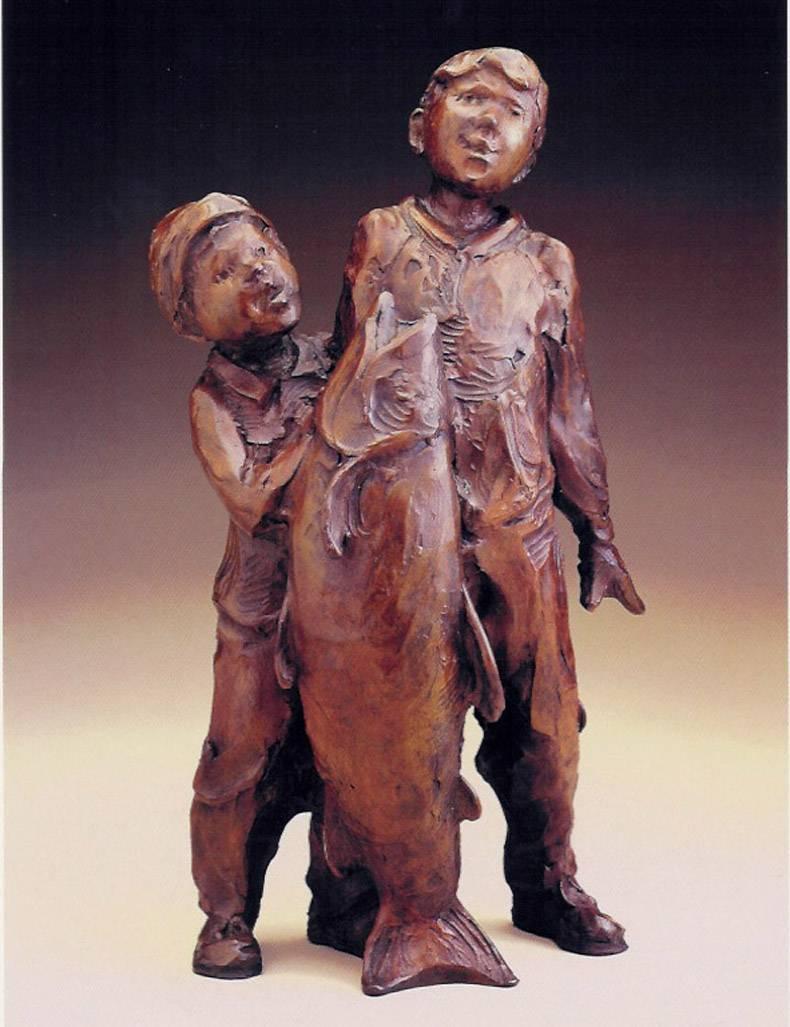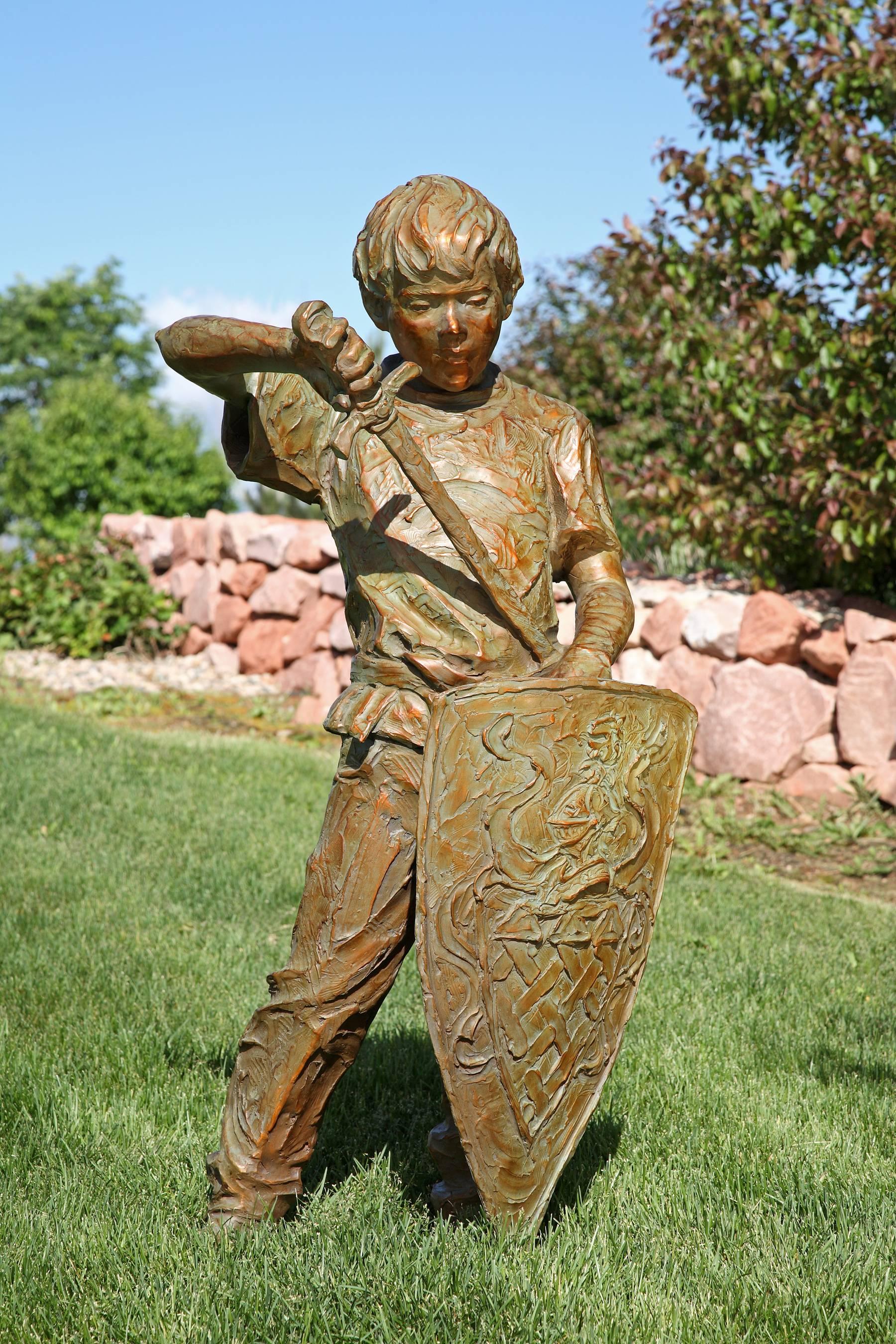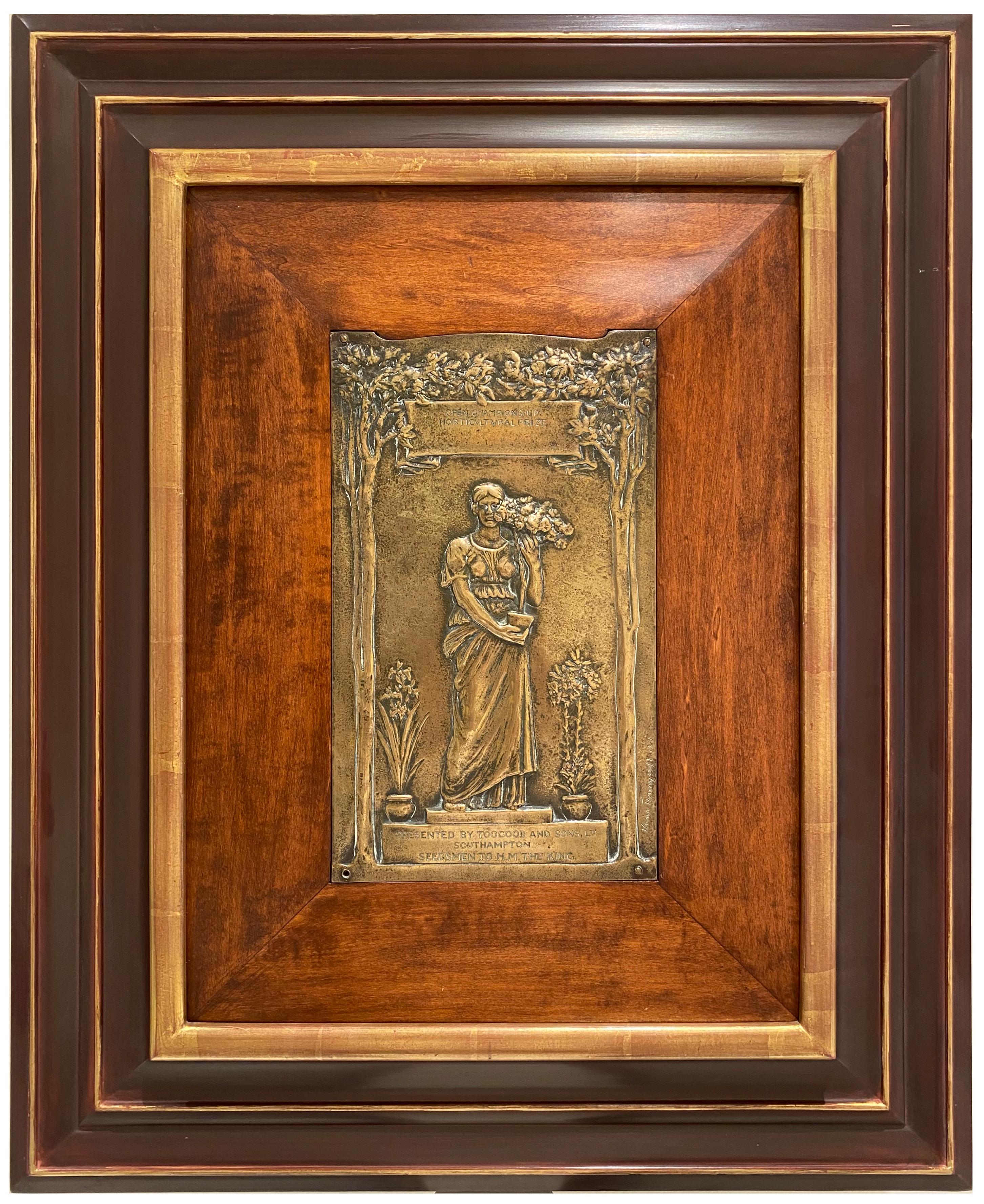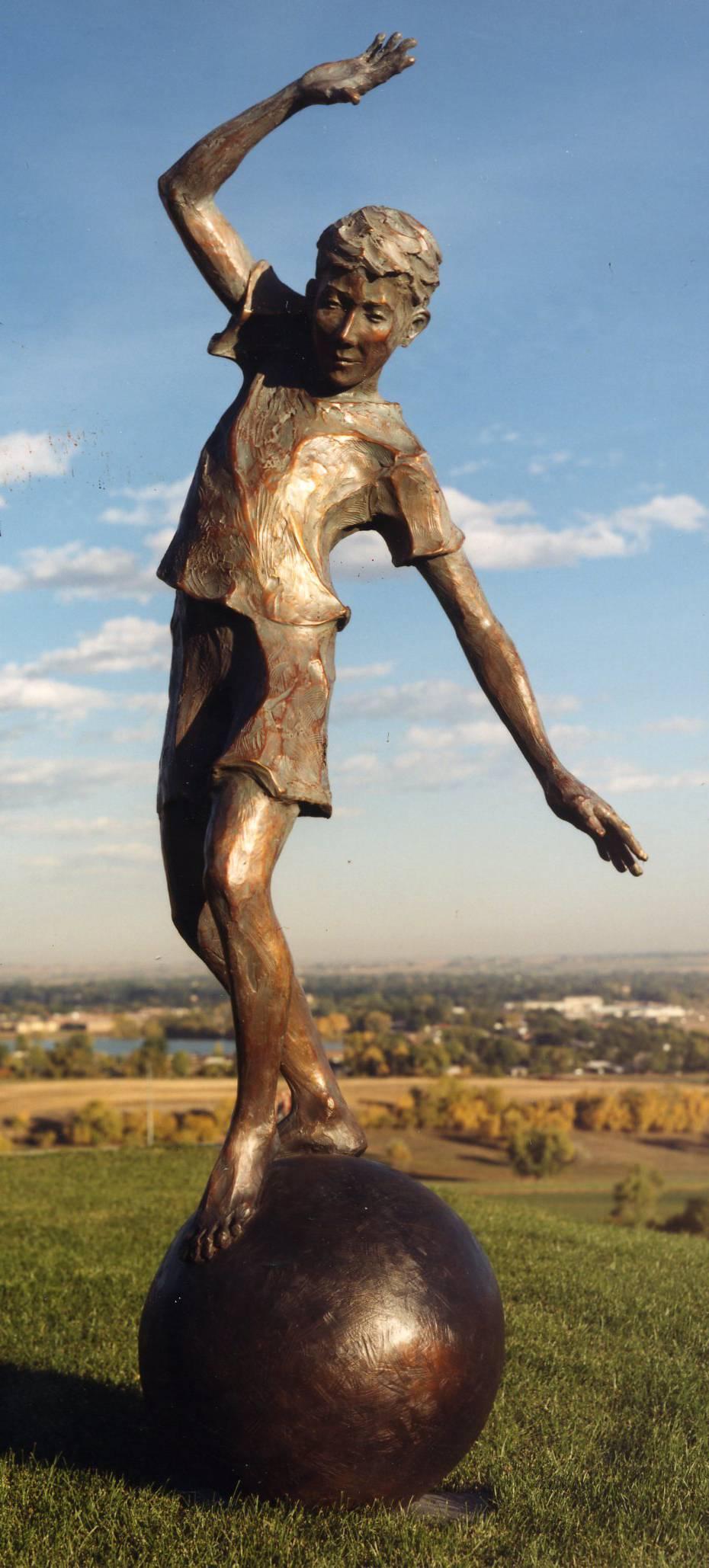Items Similar to The Hunter and Hound
Want more images or videos?
Request additional images or videos from the seller
1 of 5
Pierre Jules MêneThe Hunter and Hound1879
1879
About the Item
Pierre-Jules Mene
"The Hunter and Hound" (Le Valet de Limier) 1879
Bronze
approx. 19 x 8 x 14 inches
Signed
PIERRE JULES MENE (1810-1879)
Pierre Jules Mene, (P. J. Mene), was born in Paris in March of 1810 and died in Paris at number 9 Rue de L'Entrepot on May 21, 1879. The son of a metal turner, he received his earliest teaching on sculpture and foundry work from his father, and he opened his own foundry in the 1850s, creating lost-wax castings of his sculptures in bronze. Although mostly self-taught, Mene was encouraged by sculptor Rene Compaire, and was also influenced by two painters: Edwin Landseer of England with his expressive sentimentality, as well as Carle Vernet of France, in capturing spirit, grace and compositional beauty in sculptural form.
Much of Mene's early studies were made at the "Jardin des Plantes" in Paris, where he developed great talent for animal sculpture. He first exhibited the bronze statuette entitled Dog and Fox at the Paris Salon in 1838, and from that time exhibited regularly until his death. He received four awards from the Paris Salon: Second Class in 1848, First Class in 1852 and 1861, and a Third Class award in 1855. Mene did not sculpt statues, but rather bronze statuettes generally of domestic and farm animals at rest, (horses, dogs, cows, bulls, sheep and goats). He modeled over 150 subjects, and received the "Cross of the Legion of Honor" in 1861. He exhibited in England at the Great Expositions of 1855, 1867 and 1878, where he was praised as the "Landseer" of sculpture.
P. J. Mene was one of the most prolific and popular sculptors of the Animalier School, as well as one of it's earliest pioneers. His sculptures were widely collected by the public. His only sculpture acquired by the State of France during his lifetime was the bronze Mounted Huntsman and His Hounds. Charming and charismatic, Mene was accepted socially within the various French artistic communities.
Mene's earliest works, (such as Tiger and Alligator), reflected Antoine-Louis Barye's influence, but in contrast with the romantic style of Barye, Mene's style evolved in a contrasting way. He excelled in realistic portrayals of animals, sculpting each in their natural habitat, capturing fleeting movements and delicate details. Generally, his sculptures were portraits with a hint of human personality. Mene was praised for his "perfection in modeling the figures of animals, and for the truth and beauty of his representations." He worked in the Juste Milieu, blending romantic and naturalist elements while retaining a degree of traditionalism.
Mene's casts were of the highest quality and patinas. The last cast of an addition was edited as sharply as the first, and he was meticulous in the after work of his bronze casts, chiseling extremely fine details. His bronzes were signed in block letters "P. J. Mene" with no foundry marks. He taught his son-in-law, Auguste Cain, who continued Mene's foundries from 1879 to 1892. Subsequently, Mene's models were sold to the Susse Freres Foundry which cast well into the 20th century. Many recasts have been produced.
- Creator:Pierre Jules Mêne (1810 - 1879, French)
- Creation Year:1879
- Dimensions:Height: 19 in (48.26 cm)Width: 8 in (20.32 cm)Depth: 14 in (35.56 cm)
- Medium:
- Movement & Style:
- Period:
- Condition:
- Gallery Location:Missouri, MO
- Reference Number:1stDibs: LU74733396371
About the Seller
5.0
Vetted Seller
These experienced sellers undergo a comprehensive evaluation by our team of in-house experts.
Established in 1970
1stDibs seller since 2017
142 sales on 1stDibs
Typical response time: 21 hours
- ShippingRetrieving quote...Ships From: Missouri, MO
- Return PolicyA return for this item may be initiated within 2 days of delivery.
More From This SellerView All
- Jockey On HorsebackBy Hans GuradzeLocated in Missouri, MOHans Guradze (German, 1861-1922) "Jockey On Horseback" Bronze Approx. 19.5 x 17 x 6 inches Signed "H. Guradze Berlin" on BaseCategory
1890s Realist Figurative Sculptures
MaterialsBronze
- Native American in CanoeBy Carl KaubaLocated in Missouri, MOCarl Kauba (1865-1922) "Native American in Canoe" Polychrome Bronze Signed approx 5.5 x 10 x 2.75 inches This Austrian sculptor was born in Vienna in 1865. His teachers were Karl Waschmann (1848-1905), known for his ivory sculptures and portrait plaquettes of contemporary celebrities, and Stefan Schwartz (1851-1924), who exhibited in Paris, including the Exposition Universelle of 1900 where he won a gold medal. Kauba's intricate bronzes, imported to the United States between 1895 and 1912, were cast at the Roman Bronze Works. Kauba was part of the nineteenth-century tradition of polychrome bronze sculpture. There were several types of patinas on a single statue: he could render the color of buckskin, variously tinted shirts, blankets, feathers, as well as beaded moccasins. Reportedly, Kauba came to America around 1886. Inspired by the Western tales of German author Karl May, he traveled to the West and made sketches and models. Critics, however, pointed out inaccuracies of costume and other details. For instance, the guns that his "mid-nineteenth-century" figures use are models produced after 1898. Apparently he did all of his works back in Vienna. Besides the variety of color, Kauba's bronzes show a great range of textures and his style is highly naturalistic. The sculptor loved ornament, some of which he rendered with coiled wire for reins, rope and feathers in headdresses. He successfully rendered figures in motion and often executed compositions with more than one figure. Berman (1974) illustrates non-Western subjects by Kaula, such as the pendants Where? and There (ca. 1910), a seated Scottish couple, impressive in the expressions and the details on patterned fabrics of both sitters. Another genre piece is Buster Brown...Category
Early 20th Century Realist Figurative Sculptures
MaterialsBronze
- Study AimBy Carl KaubaLocated in Missouri, MOCarl Kauba "Study Aim" c. 1920 Bronze with Brown Patina Signed approx. 9.5 x 10 x 4 This Austrian sculptor was born in Vienna in 1865. His teachers were Karl Waschmann (1848-1905), known for his ivory sculptures and portrait plaquettes of contemporary celebrities, and Stefan Schwartz (1851-1924), who exhibited in Paris, including the Exposition Universelle of 1900 where he won a gold medal. Kauba's intricate bronzes, imported to the United States between 1895 and 1912, were cast at the Roman Bronze Works. Kauba was part of the nineteenth-century tradition of polychrome bronze sculpture. There were several types of patinas on a single statue: he could render the color of buckskin, variously tinted shirts, blankets, feathers, as well as beaded moccasins. Reportedly, Kauba came to America around 1886. Inspired by the Western tales of German author Karl May, he traveled to the West and made sketches and models. Critics, however, pointed out inaccuracies of costume and other details. For instance, the guns that his "mid-nineteenth-century" figures use are models produced after 1898. Apparently he did all of his works back in Vienna. Besides the variety of color, Kauba's bronzes show a great range of textures and his style is highly naturalistic. The sculptor loved ornament, some of which he rendered with coiled wire for reins, rope and feathers in headdresses. He successfully rendered figures in motion and often executed compositions with more than one figure. Berman (1974) illustrates non-Western subjects by Kaula, such as the pendants Where? and There (ca. 1910), a seated Scottish couple, impressive in the expressions and the details on patterned fabrics of both sitters. Another genre piece is Buster Brown...Category
Early 20th Century Realist Figurative Sculptures
MaterialsBronze
- Going into BattleBy Carl KaubaLocated in Missouri, MOCarl Kauba "Going into Battle" c. 1920s Bronze with Brown Patina Signed approx 10 x 10 x 4 (including wooden base) This Austrian sculptor was born in Vienna in 1865. His teachers were Karl Waschmann (1848-1905), known for his ivory sculptures and portrait plaquettes of contemporary celebrities, and Stefan Schwartz (1851-1924), who exhibited in Paris, including the Exposition Universelle of 1900 where he won a gold medal. Kauba's intricate bronzes, imported to the United States between 1895 and 1912, were cast at the Roman Bronze Works. Kauba was part of the nineteenth-century tradition of polychrome bronze sculpture. There were several types of patinas on a single statue: he could render the color of buckskin, variously tinted shirts, blankets, feathers, as well as beaded moccasins. Reportedly, Kauba came to America around 1886. Inspired by the Western tales of German author Karl May, he traveled to the West and made sketches and models. Critics, however, pointed out inaccuracies of costume and other details. For instance, the guns that his "mid-nineteenth-century" figures use are models produced after 1898. Apparently he did all of his works back in Vienna. Besides the variety of color, Kauba's bronzes show a great range of textures and his style is highly naturalistic. The sculptor loved ornament, some of which he rendered with coiled wire for reins, rope and feathers in headdresses. He successfully rendered figures in motion and often executed compositions with more than one figure. Berman (1974) illustrates non-Western subjects by Kaula, such as the pendants Where? and There (ca. 1910), a seated Scottish couple, impressive in the expressions and the details on patterned fabrics of both sitters. Another genre piece is Buster Brown...Category
Early 20th Century Realist Figurative Sculptures
MaterialsBronze
- Mountain GoatBy Jules MoigniezLocated in Missouri, MOJules Moigniez "Mountain Goat" Bronze approx 11 x 9 x 4 inches Signed Jules Moigniez (1835-1894) Jules Moigniez was born in Senlis sur L'Oise, France ...Category
1870s Realist Figurative Sculptures
MaterialsBronze
- Chien Braque (Tom)By Pierre Jules MêneLocated in Missouri, MOPierre Jules Mene "Chien Braque" (Tom) Bronze approx. 5 x 9 x 4.25 Signed PIERRE JULES MENE (1810-1879) Pierre Jules Mene, (P. J. Mene), was born in Pa...Category
1860s Realist Figurative Sculptures
MaterialsBronze
You May Also Like
- Big Fish StoryBy Jane DeDeckerLocated in Greenwich, CTSculpture of two boys displaying a sizeable catch.Category
1990s Realist Figurative Sculptures
MaterialsBronze
- Making FriendsBy Jane DeDeckerLocated in Greenwich, CTSculpture of a young girl holding a bowl for a cat.Category
Early 2000s Realist Figurative Sculptures
MaterialsBronze
- DavidBy Jane DeDeckerLocated in Greenwich, CTLife-size sculpture of a young boy with sword and heraldic shield.Category
Early 2000s Realist Figurative Sculptures
MaterialsBronze
- Horticulture, Garden Prize relief wall hangingLocated in Greenwich, CTA unique wall piece that is a great gift for any avid gardener or lover of horticulture. Sit Hamo Thornycroft would become one of the youngest members of the Royal Academy, achieve the Medal of Honour at the Paris Exhibition in 1900, and be knighted in 1917. Working in a transitional style between that of the neo-classicists of his parent’s generation and the Modernist style of the 20th century, Thornycroft carved out a niche as a figurative sculptor and noted modeler of public monuments in and around London. Toogoods and Sons, Ltd, established in the early nineteenth century, had, by the turn of the century, grown to become the largest seed company...Category
1920s Realist Figurative Sculptures
MaterialsBronze
- "From the Heart", Martin Eichinger, Figurative, Bronze, Romantic, 62x38x33 in.By Martin EichingerLocated in Dallas, TXThe male figure lies atop a cresting wavelike column, seemingly elevated by the experience. One hand is nearly touching his heart while the other hand is held open in a gesture of re...Category
Early 2000s Realist Figurative Sculptures
MaterialsBronze
- Keeping the Ball RollingBy Jane DeDeckerLocated in Greenwich, CTLife-size sculpture of a bare-footed boy balancing himself atop a ball.Category
1980s Realist Figurative Sculptures
MaterialsBronze





